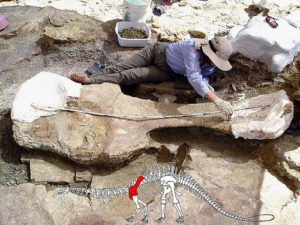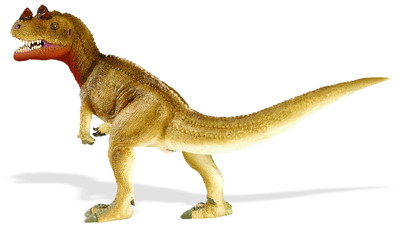Adding to Colorado’s Rich Jurassic Heritage
“Tossed Salad” of Dinosaur Bones Being Excavated by Volunteers
Local volunteers, palaeontologists and State Rangers are working together to excavate and preserve a “treasure trove” of Upper Jurassic vertebrate fossils in a series of quarries located within the borders of the Comanche National Grassland preserve in south-eastern Colorado (United States of America). The area within the designated boundaries of the Comanche National Grassland consists of pristine prairie land interspersed with canyons and ranch lands.
There are a number of such locations in the United States, afforded the same protection and security as the country’s State Forests.
Trace and Body Fossils
Dinosaur tracks and body fossils have been known from this part of Colorado, approximately 200 miles south-east of the city of Denver, for many years. For example, in the 150 metres deep Picket Wire Canyon, a set of sauropod footprints can be followed, running alongside the Purgatoire river. These dustbin lid sized impressions preserved in the rock are some of the best preserved dinosaur footprints in the whole of the Morrison Formation.
Last autumn a tooth of a ceratosaur was discovered at this locality. The dagger-like tooth was approximately 150 million years old and would have belonged to one of the apex predators of the Morrison Formation strata. A quarry located close to the bottom of one of the canyons has yielded a large number of rather jumbled dinosaur bones.
To date, palaeontologists have identified bones from sauropods such as the diplodocid Apatosaurus, a relative of Brachiosaurus called Camarasaurus along with the bones of theropod, meat-eating dinosaurs such as ceratosaurs and the much larger Allosaurus. There has also been a report of the discovery of a limb bone that may represent a genus of Stegosaurus.
An Illustration of a Typical Ceratosaurus
Picture credit: Everything Dinosaur
The picture (above) shows a Wild Safari Dinos Ceratosaurus dinosaur model.
To view the Safari Ltd range: Wild Safari Prehistoric World Figures.
Rich Fossil Heritage
The jumbled up bones seemed to have formed on a sand and gravel bank in the middle of a Late Jurassic river system. The bodies of dinosaurs were washed up against this natural obstacle during times of flooding. The water slowing down and gradually giving up its load of dead animal and plant remains. The rotting carcases attracted a number of scavenging dinosaurs, pterosaurs and crocodiles and many of the bones have traces of bite marks preserved on them. The scavenging animals would have scattered the bones further as they ripped open the carcases and disturbed the remains, (the phrase dinoturbation comes to mind).
Volunteers chosen by the scientific staff from the Denver Museum of Nature and Science have been busy working to help excavate, stabilise and preserve the fossil material. So much fossil material has been discovered that dozens of volunteers have been kept busy at the quarry location, mapping the site as well as excavating and preserving the fossils.
Working on the Fossils at the Dig Site

A scapula from a diplodocid with a skeletal drawing showing bone placement. Picture credit: Denver Museum of Nature and Science.
Picture credit: Denver Museum of Nature and Science
The picture above shows a scapula (shoulder blade) of a large diplodocid dinosaur at the dig site. It has been speculated that his fossilised bone is from an Apatosaurus.
The teams have been working in conjunction with the country’s Forest State service. A palaeontologist for the Forest Service, Bruce Schumacher commented on the importance of the Comanche National Grassland location.
He stated:
“Discoveries such as this allow scientists to better reconstruct ancient ecosystems of the past. In learning about these past worlds, we are able to reflect better on our present world and understand what impact man is having on the present ecosystem.”
Groups of Volunteers
Working with groups of volunteers under the guidance of experts from the Denver Museum of Nature and Science, something like fifty fossil bearing sites have been explored so far. The Forest State service are confident that the fossils that are unearthed within the boundary of the Comanche National Grassland will help palaeontologists to piece together more information about life for these large reptiles during the Late Jurassic. They are also hopeful that the abundance of fossil material may even yield a new species of dinosaur, one that when scientifically named and described may forever link the Comanche National Grasslands with the science of vertebrate palaeontology.
This article has been compiled using information from the United States Department of Agriculture.


